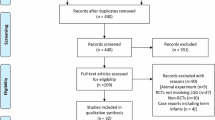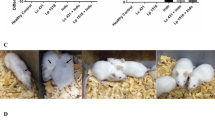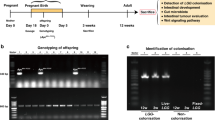Abstract
Necrotizing enterocolitis (NEC) remains a leading cause of morbidity and mortality in preterm infants. Although its pathogenesis is poorly understood, inappropriate apoptosis of the mucosal epithelia has been implicated. Recent clinical trials have shown that probiotics may reduce the incidence of NEC, and probiotics have been shown to suppress intestinal epithelial apoptosis in cultured cells. However, little is known about their mechanism of action in the developing intestine in vivo. Here, we confirm that the probiotic Lactobacillus rhamnosus GG (LGG) reduces chemically induced intestinal epithelial apoptosis in vitro. Furthermore, we report for the first time that LGG administered orally to live animals can reduce chemically induced epithelial apoptosis ex vivo, as measured by staining for active caspase 3 and terminal deoxynucleotidyltransferase. Using cDNA microarray analysis from the intestine of live, orally inoculated mice, we show that LGG up-regulates a battery of genes with known and likely cytoprotective effects. These studies indicate that probiotics such as LGG may augment intestinal host defenses in the developing intestine by stimulating antiapoptotic and cytoprotective responses. Because apoptosis may be a precursor to NEC, understanding the mechanism behind probiotic modulation of apoptotic pathways may allow for development of more specifically targeted therapies or preventive strategies in the future.
Similar content being viewed by others
Log in or create a free account to read this content
Gain free access to this article, as well as selected content from this journal and more on nature.com
or
Abbreviations
- HPF:
-
high power field
- GG:
-
Lactobacillus rhamnosus GG
- STS:
-
staurosporine
- VLBW:
-
very low birthweight
References
Lin PW, Stoll BJ 2006 Necrotising enterocolitis. Lancet 368: 1271–1283
Grave GD, Nelson SA, Walker WA, Moss RL, Dvorak B, Hamilton FA, Higgins R, Raju TN 2007 New therapies and preventive approaches for necrotizing enterocolitis: report of a research planning workshop. Pediatr Res 62: 510–514
Neu J 2005 Neonatal necrotizing enterocolitis: an update. Acta Paediatr Suppl 94: 100–105
Dai D, Walker WA 1998 Role of bacterial colonization in neonatal necrotizing enterocolitis and its prevention. Zhonghua Min Guo Xiao Er Ke Yi Xue Hui Za Zhi 39: 357–365
Jilling T, Lu J, Jackson M, Caplan MS 2004 Intestinal epithelial apoptosis initiates gross bowel necrosis in an experimental rat model of neonatal necrotizing enterocolitis. Pediatr Res 55: 622–629
Leaphart CL, Cavallo J, Gribar SC, Cetin S, Li J, Branca MF, Dubowski TD, Sodhi CP, Hackam DJ 2007 A critical role for TLR4 in the pathogenesis of necrotizing enterocolitis by modulating intestinal injury and repair. J Immunol 179: 4808–4820
Clark JA, Lane RH, Maclennan NK, Holubec H, Dvorakova K, Halpern MD, Williams CS, Payne CM, Dvorak B 2005 Epidermal growth factor reduces intestinal apoptosis in an experimental model of necrotizing enterocolitis. Am J Physiol Gastrointest Liver Physiol 288: G755–G762
Zeng H, Wu H, Sloane V, Jones R, Yu Y, Lin P, Gewirtz AT, Neish AS 2006 Flagellin/TLR5 responses in epithelia reveal intertwined activation of inflammatory and apoptotic pathways. Am J Physiol Gastrointest Liver Physiol 290: G96–G108
Ford H, Watkins S, Reblock K, Rowe M 1997 The role of inflammatory cytokines and nitric oxide in the pathogenesis of necrotizing enterocolitis. J Pediatr Surg 32: 275–282
Santulli TV, Schullinger JN, Heird WC, Gongaware RD, Wigger J, Barlow B, Blanc WA, Berdon WE 1975 Acute necrotizing enterocolitis in infancy: a review of 64 cases. Pediatrics 55: 376–387
Stoll BJ, Gordon T, Korones SB, Shankaran S, Tyson JE, Bauer CR, Fanaroff AA, Lemons JA, Donovan EF, Oh W, Stevenson DK, Ehrenkranz RA, Papile LA, Verter J, Wright LL 1996 Early-onset sepsis in very low birth weight neonates: a report from the National Institute of Child Health and Human Development Neonatal Research Network. J Pediatr 129: 72–80
Fanaro S, Chierici R, Guerrini P, Vigi V 2003 Intestinal microflora in early infancy: composition and development. Acta Paediatr Suppl 91: 48–55
Hoy CM, Wood CM, Hawkey PM, Puntis JW 2000 Duodenal microflora in very-low-birth-weight neonates and relation to necrotizing enterocolitis. J Clin Microbiol 38: 4539–4547
de la Cochetiere MF, Piloquet H, des Robert C, Darmaun D, Galmiche JP, Roze JC 2004 Early intestinal bacterial colonization and necrotizing enterocolitis in premature infants: the putative role of Clostridium. Pediatr Res 56: 366–370
Bourlioux P, Koletzko B, Guarner F, Braesco V 2003 The intestine and its microflora are partners for the protection of the host: report on the Danone Symposium “The Intelligent Intestine,” held in Paris, June 14, 2002. Am J Clin Nutr 78: 675–683
Hooper LV, Wong MH, Thelin A, Hansson L, Falk PG, Gordon JI 2001 Molecular analysis of commensal host-microbial relationships in the intestine. Science 291: 881–884
Kelly D, Campbell JI, King TP, Grant G, Jansson EA, Coutts AG, Pettersson S, Conway S 2004 Commensal anaerobic gut bacteria attenuate inflammation by regulating nuclear-cytoplasmic shuttling of PPAR-gamma and RelA. Nat Immunol 5: 104–112
Collier-Hyams LS, Sloane V, Batten BC, Neish AS 2005 Cutting edge: bacterial modulation of epithelial signaling via changes in neddylation of cullin-1. J Immunol 175: 4194–4198
Tao Y, Drabik KA, Waypa TS, Musch MW, Alverdy JC, Schneewind O, Chang EB, Petrof EO 2006 Soluble factors from Lactobacillus GG activate MAPKs and induce cytoprotective heat shock proteins in intestinal epithelial cells. Am J Physiol Cell Physiol 290: C1018–C1030
Yan F, Polk DB 2002 Probiotic bacterium prevents cytokine-induced apoptosis in intestinal epithelial cells. J Biol Chem 277: 50959–50965
Akisu M, Baka M, Yalaz M, Huseyinov A, Kultursay N 2003 Supplementation with Saccharomyces boulardii ameliorates hypoxia/reoxygenation-induced necrotizing enterocolitis in young mice. Eur J Pediatr Surg 13: 319–323
Butel MJ, Roland N, Hibert A, Popot F, Favre A, Tessedre AC, Bensaada M, Rimbault A, Szylit O 1998 Clostridial pathogenicity in experimental necrotising enterocolitis in gnotobiotic quails and protective role of bifidobacteria. J Med Microbiol 47: 391–399
Caplan MS, Miller-Catchpole R, Kaup S, Russell T, Lickerman M, Amer M, Xiao Y, Thomson R Jr 1999 Bifidobacterial supplementation reduces the incidence of necrotizing enterocolitis in a neonatal rat model. Gastroenterology 117: 577–583
Bin-Nun A, Bromiker R, Wilschanski M, Kaplan M, Rudensky B, Caplan M, Hammerman C 2005 Oral probiotics prevent necrotizing enterocolitis in very low birth weight neonates. J Pediatr 147: 192–196
Dani C, Biadaioli R, Bertini G, Martelli E, Rubaltelli FF 2002 Probiotics feeding in prevention of urinary tract infection, bacterial sepsis and necrotizing enterocolitis in preterm infants. A prospective double-blind study. Biol Neonate 82: 103–108
Hoyos AB 1999 Reduced incidence of necrotizing enterocolitis associated with enteral administration of Lactobacillus acidophilus and Bifidobacterium infantis to neonates in an intensive care unit. Int J Infect Dis 3: 197–202
Lin HC, Su BH, Chen AC, Lin TW, Tsai CH, Yeh TF, Oh W 2005 Oral probiotics reduce the incidence and severity of necrotizing enterocolitis in very low birth weight infants. Pediatrics 115: 1–4
Yan F, Cao H, Cover TL, Whitehead R, Washington MK, Polk DB 2007 Soluble proteins produced by probiotic bacteria regulate intestinal epithelial cell survival and growth. Gastroenterology 132: 562–575
Belmokhtar CA, Hillion J, Segal-Bendirdjian E 2001 Staurosporine induces apoptosis through both caspase-dependent and caspase-independent mechanisms. Oncogene 20: 3354–3362
Harkin ST, Cohen GM, Gescher A 1998 Modulation of apoptosis in rat thymocytes by analogs of staurosporine: lack of direct association with inhibition of protein kinase C. Mol Pharmacol 54: 663–670
McCracken VJ, Lorenz RG 2001 The gastrointestinal ecosystem: a precarious alliance among epithelium, immunity and microbiota. Cell Microbiol 3: 1–11
Zeng H, Carlson AQ, Guo Y, Yu Y, Collier-Hyams LS, Madara JL, Gewirtz AT, Neish AS 2003 Flagellin is the major proinflammatory determinant of enteropathogenic Salmonella. J Immunol 171: 3668–3674
Collier-Hyams LS, Zeng H, Sun J, Tomlinson AD, Bao ZQ, Chen H, Madara JL, Orth K, Neish AS 2002 Cutting edge: Salmonella AvrA effector inhibits the key proinflammatory, anti-apoptotic NF-kappa B pathway. J Immunol 169: 2846–2850
Neu J, Caicedo R 2005 Probiotics: protecting the intestinal ecosystem?. J Pediatr 147: 143–146
Boldrick JC, Alizadeh AA, Diehn M, Dudoit S, Liu CL, Belcher CE, Botstein D, Staudt LM, Brown PO, Relman DA 2002 Stereotyped and specific gene expression programs in human innate immune responses to bacteria. Proc Natl Acad Sci USA 99: 972–977
Huang Q, Liu D, Majewski P, Schulte LC, Korn JM, Young RA, Lander ES, Hacohen N 2001 The plasticity of dendritic cell responses to pathogens and their components. Science 294: 870–875
Eckmann L, Smith JR, Housley MP, Dwinell MB, Kagnoff MF 2000 Analysis by high density cDNA arrays of altered gene expression in human intestinal epithelial cells in response to infection with the invasive enteric bacteria Salmonella. J Biol Chem 275: 14084–14094
Mazumder S, Plesca D, Kinter M, Almasan A 2007 Interaction of a cyclin E fragment with Ku70 regulates Bax-mediated apoptosis. Mol Cell Biol 27: 3511–3520
Pramoonjago P, Baras AS, Moskaluk CA 2006 Knockdown of Sox4 expression by RNAi induces apoptosis in ACC3 cells. Oncogene 25: 5626–5639
Podcheko A, Northcott P, Bikopoulos G, Lee A, Bommareddi SR, Kushner JA, Farhang-Fallah J, Rozakis-Adcock M 2007 Identification of a WD40 repeat-containing isoform of PHIP as a novel regulator of beta-cell growth and survival. Mol Cell Biol 27: 6484–6496
Tewari M, Yu M, Ross B, Dean C, Giordano A, Rubin R 1997 AAC-11, a novel cDNA that inhibits apoptosis after growth factor withdrawal. Cancer Res 57: 4063–4069
Ruchatz H, Coluccia AM, Stano P, Marchesi E, Gambacorti-Passerini C 2003 Constitutive activation of Jak2 contributes to proliferation and resistance to apoptosis in NPM/ALK-transformed cells. Exp Hematol 31: 309–315
Cerignoli F, Rahmouni S, Ronai Z, Mustelin T 2006 Regulation of MAP kinases by the VHR dual-specific phosphatase: implications for cell growth and differentiation. Cell Cycle 5: 2210–2215
Rakoff-Nahoum S, Paglino J, Eslami-Varzaneh F, Edberg S, Medzhitov R 2004 Recognition of commensal microflora by toll-like receptors is required for intestinal homeostasis. Cell 118: 229–241
Abreu MT, Vora P, Faure E, Thomas LS, Arnold ET, Arditi M 2001 Decreased expression of Toll-like receptor-4 and MD-2 correlates with intestinal epithelial cell protection against dysregulated proinflammatory gene expression in response to bacterial lipopolysaccharide. J Immunol 167: 1609–1616
Rachmilewitz D, Katakura K, Karmeli F, Hayashi T, Reinus C, Rudensky B, Akira S, Takeda K, Lee J, Takabayashi K, Raz E 2004 Toll-like receptor 9 signaling mediates the anti-inflammatory effects of probiotics in murine experimental colitis. Gastroenterology 126: 520–528
Sartor RB 2004 Therapeutic manipulation of the enteric microflora in inflammatory bowel diseases: antibiotics, probiotics, and prebiotics. Gastroenterology 126: 1620–1633
Kliegman RM, Willoughby RE 2005 Prevention of necrotizing enterocolitis with probiotics. Pediatrics 115: 171–172
Author information
Authors and Affiliations
Corresponding author
Additional information
Supported by an Emory Egleston Children's Research Center seed grant (P.W.L.), the National Institutes of Health grants DK062851 and DK076613 (P.W.L.), AI051282 and DK071604 (A.S.N.), and Emory Digestive Disease Research Center Grant R24 DK-064399.Both P.W.L. and T.R.N. contributed equally to these studies.
Rights and permissions
About this article
Cite this article
Lin, P., Nasr, T., Berardinelli, A. et al. The Probiotic Lactobacillus GG may Augment Intestinal Host Defense by Regulating Apoptosis and Promoting Cytoprotective Responses in the Developing Murine Gut. Pediatr Res 64, 511–516 (2008). https://doi.org/10.1203/PDR.0b013e3181827c0f
Received:
Accepted:
Issue date:
DOI: https://doi.org/10.1203/PDR.0b013e3181827c0f
This article is cited by
-
Studies on host-foodborne bacteria in intestinal three-dimensional cell culture model indicate possible mechanisms of interaction
World Journal of Microbiology and Biotechnology (2021)
-
Bifidobacterium and Lactobacillus for preventing necrotizing enterocolitis in very-low-birth-weight preterm infants: a systematic review and meta-analysis
World Journal of Pediatrics (2020)
-
Functional Properties of Food Origin Lactobacillus in the Gastrointestinal Ecosystem—In Vitro Study
Probiotics and Antimicrobial Proteins (2019)
-
Design and validation of an orally administrated active L. fermentum-L. acidophilus probiotic formulation using colorectal cancer Apc Min/+ mouse model
Applied Microbiology and Biotechnology (2017)
-
Lactobacillus acidophilus Increases the Anti-apoptotic Micro RNA-21 and Decreases the Pro-inflammatory Micro RNA-155 in the LPS-Treated Human Endothelial Cells
Probiotics and Antimicrobial Proteins (2016)



